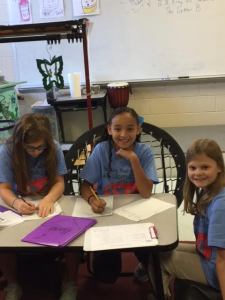Academic Enrichment
Cigar Box Odyssey: Enriching Creative Process Skills
Fourth graders stimulate the thinking processes involved in creativity through an Academic Enrichment Grant

As we face many challenges in educating our children, it is important to emphasize creative thinking and problem solving. Creative thinking and problem-solving are essential parts of the process to turn ideas into innovation and open up avenues to creativity.
What were the goals of the Cigar Box Odyssey project?
The overall goal of the Cigar Box Odyssey project was to teach creativity by integrating the Outcomes of their gifted program with the Objectives of their Fourth Grade Curriculum. Their goal was achieved by emphasizing the gifted process skills of performance, presentation, research, creativity, self-directed learning, group dynamics, and understanding and creating art. The students analyzed the creative process used by musicians to design the cigar box guitar using the SCAMPER (Substitute; Combine; Adapt; Modify; Put to another use; Eliminate; Reverse) technique.
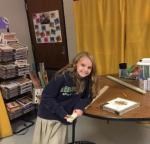
What is the SCAMPER technique?
The SCAMPER technique (introduced Bob Eberle, as described in the design thinking blog, Designorate, by Rafiq Elmansy) is based on the idea that what is new is actually an adaptation of something that already existed. It is considered one of the easiest and most direct methods to creative thinking. The SCAMPER keywords noted above represent the necessary questions students should address during the creative thinking process. For example, for Substitute one could ask, “What part of the process can be substituted without affecting the whole project?” or for Combine, one could ask, “Can we merge two steps of the process?”
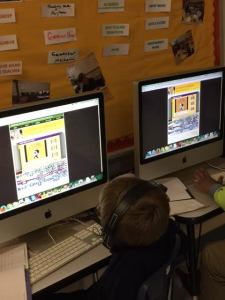
- Project caption “We begin research and building guitars at the same time. We use sites like PBS Blues Road Trip and Carnegie Hall History of the Blues.”
What skills did students use to build their Cigar Box Guitars?

The students researched the origin of the Delta Blues and how the Blues form travelled and changed, influencing other American music forms. They used measuring skills, basic knowledge of sound, and creative principles to build their own cigar box guitars. Then the students wrote original songs and performed them in a Blues Café that was set up in their classroom.
The students attended the New Orleans Cigar Box Guitar Music Festival where they were well received and able to meet professional performers. And, to top it off they have been invited to perform at the Festival next year. To prepare for their performance, they plan to invite T. J. Wheeler, creator of the Blues in Schools program, to College Park and help the students prepare for this performance. He taught this year’s fourth graders a few things in just a short time at the festival.
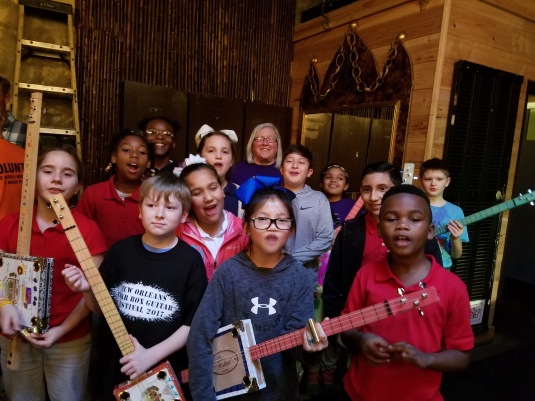
How has this program affected learning?
Because of this program the students have experienced the intersection of research and reality. They have had a taste of living what they researched and were exposed to adults who built the same instruments and performed the same kind of music. They were also able to extend the program to include some cutting-edge technology by 3D printing their own guitar picks.
So, what’s next for the students?
With the purchase of a 3D printer students will learn how to program CAD and create (not just print) their own picks. So, both the technology and the performance components of the program will be lifted to a higher plane when they learn to program CAD and perform formally in front of a festival audience.
Further reading:
The Village Science Project: Reducing Barriers to Science Education in South Sudan

While there are always needs in the schools in our own country, it is important to remember that other countries have students that have the same potential but lack even the basic resources available to many U.S. students.
This is what Candacia Greenman is aiming to address by working with the Loreto Primary School in Rumbek, South Sudan. The Village Science Project (VSP) aims to use an inquiry-driven, hands-on and play-oriented approach to improve access to high quality science education for over 200 disadvantaged students over a 3-year period in this MDEF funded academic enrichment project.
How can educators address barriers to high quality science education?
VSP intends to target the four main hindrances to science learning in their community in order to better serve the students:
- Limited resources for practical, inquiry-driven science exploration
- Poor English language acquisition
- Little community engagement
- Psychological barriers to learning
VPS’s proposed addressing these in the following ways:
- Providing students with the resources needed for science exploration through the use of science experiments and engineering and robotics projects.
- Implementing techniques to improve English language skills in science learning by promoting reading through tablets, facilitating peer learning experiences and encouraging student presentations through science fairs
- Stimulating community engagement through science fairs combined with field trips and career talks from local community members.
- Creating low-stress environments for our students, especially our girls to become interested in learning science (students are also given opportunities for “tinkering” or “free play” with science kits through the formation of an after school “tinker club”)

How can teaching methods improve students’ love for science?
Loreto Primary School serves over 600 students, with an emphasis on girls’ education and VSP will benefit about 200 different upper primary students over 3 years. The students live in a community with limited access to electricity and potable water and currently, classes are conducted outdoors under trees.
Most of these students never get a real chance to find a love of science because it’s taught almost exclusively in a theoretical, teacher-centered manner. As such, VSP is ground-breaking because of its use of a more hands-on and child-centered methodology to elevate student learning. They’ll do this by keeping a strong focus on inquiry-driven science exploration, which will help these students to develop their critical thinking skills. VSP will also deepen students understanding of, and interaction with the local physical environment as well as addressing social issues that adversely affect science education such as gender inequity, trauma-induced stress and poor community engagement.
At the end of year one the educators working on the VSP conducted initial baseline assessments of science performance and interest of Primary 5 and Primary 6 students after the following programs were implemented:
- Teacher demonstrations
- Laboratory exercises/activities
- Robotics and engineering projects
- Tablet usage
- Mathematics manipulatives usage
- Science fair
- Career talks
- Field trips
- Tinker Club
Revealing effective science and math teaching
The VSP team members have conducted baseline assessments in both science and mathematics enabling the teachers to tailor the rest of their programs according to how best to serve the students needs. In light of a mathematics assessment revealing gaps they’ve launched a mathematics intervention program targeting student understanding of number operations for Primary 3 through Primary 6 students. All teachers have adapted their teaching programs to allow for more time for Mathematics instruction and they have expanded their focus on number operations.
In addition, all of the primary school teachers attended a month-long training workshop to learn how to integrate demonstrations into their lesson plans for effective science teaching. In order to maximize the use of the science teaching aids, they expanded their focus to include demonstrations in Electricity, Magnetism and Weather modules.
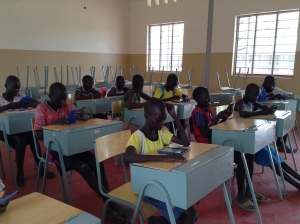
Best of all, afterschool programs to supplement students’ science education have also been implemented. In these programs, the students use science kits to expand their learning of material covered in their Electricity, Magnetism and Weather modules. Those aren’t the only exciting things going on after school for Loreto Primary School students.
VSP has also introduced programs to introduce students to engineering principles and robotics. In these programs, students have been using Engino engineering blocks to build simple machines and learn how to code using the Lightbot app as a first step towards understanding robotics. The engineering afterschool program encompasses the proposed ‘Tinker Club’ in which ‘free play’ is encouraged and students build simple machines of their choice. Students are also being provided with tablets to use in the afterschool programs to aid them in their mathematics and science courses.
One of the most exciting additions have been the science fairs which give the students a place to shine in front of Teachers, parents and other community leaders also attending the event. The science fair focused on energy and engineering and students gave presentations on the design of solar toys, the basics of electricity, and the design and utility of simple machines.

One of the greatest feathers in the cap of the VSP project is that all of their after school programs and the science fair were conducted in English and has resulted in a vast improvement in English comprehension. In addition, students have learned how to use technology and the basics of coding through the use of tablets. Their teachers have reported that tablet usage has also helped the students with Mathematics anxiety.
Lessons learned in academic enrichment
The accomplishments of this project have not come without challenges. The VSP team have reflected on ways they can improve their program in later years. Their biggest challenge was the field trips due to security concerns. As a result of this challenge, they have shifted their focus and are currently designing a “Mathematics and Science for Life” program in which students will attend weekend sessions to learn how mathematics and science are useful in everyday life. Being able to adapt and shift strategies in response to challenges is a necessity for success for a program like this.
The VSP team also learned the difficulties of relying on applications that are not as readily available on the international networks. Google Play is not enabled in South Sudan. As such, all apps must be pre-loaded before transportation to Rumbek. Unfortunately, this means that updates cannot be installed as needed. Furthermore, a lack of consistent and fast internet access has limited the utility of many apps that would be very useful for the students. And in addition to these challenges, having electricity in the classroom has been an issue. As such, they recently invested in solar energy to provide electricity to their school campus and are have installed solar electricity panels for our primary school which will improve their internet access.
All in all, it sounds like some really exciting things are going on with the VSP in Rumbek. They’re swinging with the punches and adapting when necessary. The McCarthy Dressman Education Foundation is excited to see where they go in the years ahead. If they succeed, other schools in the region will benefit enormously from the pedagogical strategies that these educators are pioneering.
Learn more about the topics in this post
- Science and Math Education for Development
- SIAM: Developing Mathematics in the Developing World
- Science Education in Developing Countries
- Revealed: World pupil rankings in science and maths
- Redefining education in the developing world



